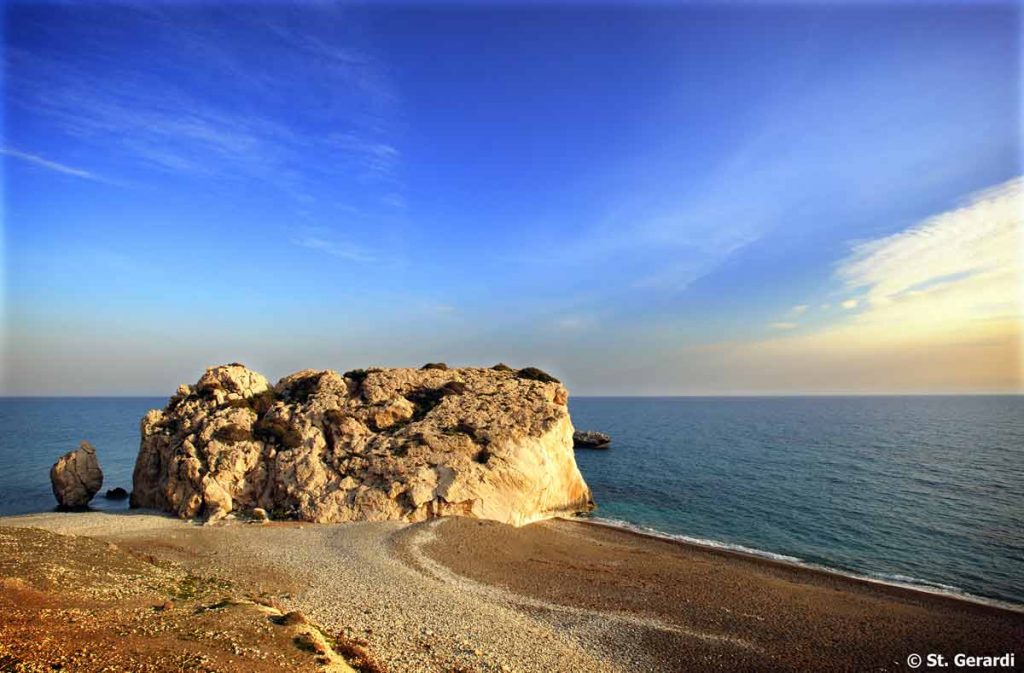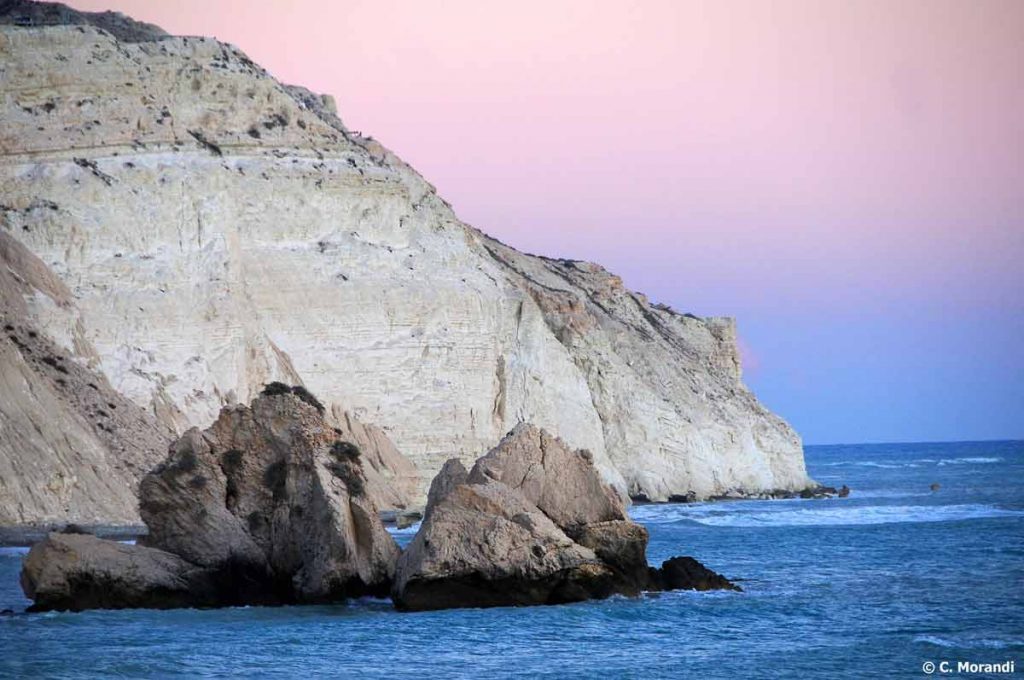Weather in Cyprus
Cyprus' climate and microclimates are...

…determined by three parameters – its latitude at 35N, geographical location towards the NE corner of the Eastern Mediterranean and land configuration – i.e. two mountain chains running west to east, the Troodos massif to the southwest, and elongated Kyrenia range to the northeast, with narrow coastal plains and a rather wide central plain (about 40km).
At latitude 35N Cyprus has daylight that fluctuates between 9.8 hrs on the winter solstice (21 or 22 December) and a high value of 14.5 hrs on summer solstice (20 or 21 June). Correspondingly, the solar elevation angle at this latitude ranges from a low of 32 degree above the horizon to a high of 78 degrees, standing at an average value of 55 degrees on spring (21 or 22 March) and autumn (22 or 23 September) equinoxes. Consequently, the amount of solar radiation received at the surface, which is a function of the above astronomical parameters, displays also a significant fluctuation through the year.
Cyprus’ geographical location, lying in the NE corner of the Eastern Mediterranean basin. This location means that the island is closest to the extensive land masses of Asia Minor to the north (closest distance 45 km) and of the Levant Coast of Western Asia to the east-southeast (closest point 60 km). On the contrary, it is separated by a broader stretch of water to the south from the Egyptian shore at a distance of about 200km. Also to the west there is a continuous body of water till the islands of Rhodes and Crete (more than 300km). The geographical location thereby affects the island’s climate in enhancing continental influences to the east and north of the island and maritime influences to the west and south.
The third parameter affecting Cyprus climate, and, in addition its microclimates is its complex land configuration with the following particular characteristics:
- The Troodos massif, occupying the SW third of the island, with highest peak Mount Olympus at 1951m;
- the elongated and rather narrow Kyrenia range, along the north coast from Cape Kormakitis to Cape Apostolos Andreas, with highest peak Kyparissovounos at 1150m.
- narrow coastal plains to the north and south of the Troodos massif and to the north of the Kyrenia range;
- the rather wide central Messaoria plain, around 40km, lying between the Troodos massif to the south and southwest and the Kyrenia range to the north, northeast; and
- the elongated (100km) and rather narrow (5-15km) Karpass peninsula, protruding north-eastwards from the main body of the island.
All the above characteristics affect to a varying degree the general climate of the island and at the same time the multitude of microclimates which constitute it.
The main effects of the land configuration parameter can be summarized as follows:
- The Troodos massif, due to its higher average elevation, enjoys lower temperatures (up to 11 degrees C lower than at sea level) and higher precipitation (up to 1100mm – as much as three times more than on the central plain) on its highest peak.
Correspondingly amounts of sunshine are lower (by 10-15%) and cloudiness higher than on the coasts and central plain. Frosts are more frequent and visibility lower than on lowlands;
- Similar orographic effects are evident, to a much reduced degree, along the Kyrenia range, due to its much lower spatial extent and lower average elevation;
- The coastal plains exhibit a greater maritime influence than the rest of the island, with higher winter -lower summer temperature, lower daily-monthly annual range of temperature, higher average humidity, fewer days with frost, higher average wind speeds and generally higher precipitation compared to the central Messaoria plain;
- The central Messaoria plain, on the contrary, exhibits more pronounced continental influences, with lower winter-higher summer temperatures, higher daily-monthly- annual range of temperature, lower average humidity, more days with frost, lower average wind speeds and generally lower precipitation compared with the coastal plains; and
- The Karpass peninsula, due to its nature, narrow width-low elevation, is affected to a greater extent by maritime influences having the characteristics of the rest of the coastal plains.




Climate Classification
Cyprus enjoys a sub-tropical Mediterranean climate – Csa – according to the Koeppen Climate Classification. Winters are mild on lowlands and cool on the mountains and wet everywhere while summers are warm to hot and dry everywhere.
Synoptic Situation – Atmospheric Pressure
During the winter (December to February) Cyprus is intersected by the Siberian continental anticyclone (intense cold, dry) over Central Asia, and a high pressure belt stretching across the Sahara (mild-dry) over North Africa. Sandwiched in between the two Highs is a relatively narrow corridor of lower pressure, along which a series of depressions cross the Mediterranean from west to east, bringing periods of wet, windy weather to the island. Also, some depressions develop in situ in the East Mediterranean region, appropriately named “Cyprus Lows”.
Typically, during January, mean monthly pressure stands at its yearly high value, reaching 1016mb at sea level. However, there are great fluctuation in daily pressure with values in the range 995mb, when a deep depression crosses the island, to near 1030mb during periods of quiet anticyclonic weather when ridges of high pressure extend to Cyprus either from the Siberian High to the NE or the Saharan High to the south (less frequent).
During summer (June to August) Cyprus is located between the outer fringes of the great continental Heat Low over Central Pakistan to the east and the outer fringes of the Azores High extending over Western Europe to the west and north. The weather is mostly fine and sunny over Cyprus with a limited potential for the development of thundery cloud over the mountains and to a lesser extent the central plain.
Typically, during July the mean monthly pressure reaches its lowest value during the year at 1005mb at sea level. Pressure fluctuations are more limited than during the winter period usually in the range of 1000mb to 1015mb.
During the transitional seasons of spring and autumn the synoptic situation is much more variable and in general the trends are the following: During spring atmospheric pressure over Cyprus is falling from winter values, winter depressions crossing the region become less and less frequent while anticyclonic spells have much lower pressure values than in winter. During autumn, on the other hand, atmospheric pressure over Cyprus is on the rise, with the decline of the Thermal Low to the east, while during anticyclonic spells pressure reaches much higher values. Towards the end of the period winter depressions become more and more frequent as the winter pattern of pressure distribution is established.
Winds
The wind regime over the island of Cyprus is determined to a large extent by the prevailing synoptic situation of its climate and by the island’s land and sea configuration.
Thus, during the winter period winds over Cyprus are rather variable in direction, depending on the position of the island vis-à-vis a series of depressions crossing the island from west to east or developing locally in the Eastern Mediterranean. Wind direction frequencies are shared between the mild, moist south-westerlies ahead of depressions and the cooler, drier north-easterlies after the passage of depressions. Winds during cyclonic periods are generally moderate in strength on the central plain and fresh to strong on exposed coasts. During anticyclonic weather, when ridges of high pressure cover the area, it is calm at night with light winds during daytime on the central plain and light to moderate on coasts and mountain areas.
During the summer period winds over Cyprus have a more regular westerly, north-westerly direction and are generally light to moderate in strength and are determined by the seasonal Heat Low over central Pakistan to the east and the higher pressures on the outer eastern fringe of the Azores High covering Western Europe to the west and north.
During the transitional “shoulder” seasons of spring and autumn there is a gradual shift from the winter to summer and summer to winter wind patterns respectively.
Synoptic effects on the wind patterns are supplemented by the parameter of land configuration.
First, due to differential heating effects of land and sea, especially during the warm half of the year, the phenomenon of sea and land breezes develops. During daytime the land heats much faster than over the sea causing a pressure differential, i.e. lower pressure over land, around midday. This causes sea breezes which blow moderate to fresh near coasts and occasionally penetrate far into the central plain, causing a welcome relief from the extreme heat. The contrary may occur during the night and may lead to the development of a land breeze especially during periods of slag pressure gradients.
Second, along the axis of mountain valleys, during the warm part of the year, the phenomenon of anabatic (up-valley) winds occurs during the day as warmed up air rises up the valley and, correspondingly, katabatic (down-valley) winds during the night when cooled air rolls down from mountain slopes to valley floors.
Gales (8Bf or more) are infrequent over Cyprus but may occur especially on exposed coasts and mountain slopes associated with steep pressure gradients of winter depressions crossing the area in winter and early spring. As a result of the scarcity of gales seas rarely reach the status “rough” in sea waters around Cyprus.
Small scale whirlwinds are common in summer usually appearing near midday as “dust devils” on the hot, dry central plain but rarely cause any damage.
Very rare vortices, near 100m in diameter with characteristic water spouts at sea or small tornado-like features over land may also occur during periods of thundery weather.
Temperatures
Cyprus is the warmest Mediterranean island (and EU country) with mean annual temperature at sea level between 19°C and 20°C. Nicosia is also the warmest European capital with an average annual temperature of 20°C (the next warmest EU capital is Athens, with a mean annual temperature of 18°C).
The island is enjoying a mild, wet winter on coasts and the central plain and a cool, wet winter on the mountains while summers are warm to hot and dry everywhere.
The annual range of temperature (i.e. the difference between the mean monthly temperature of warmest and coldest month, usually January and July/August respectively) is quite large and lies between 18-20°C on the central plain and highlands and 14-16°C on coasts, reflecting continental and maritime influences.
Typically, January, the coldest month, has a mean monthly average temperature in the range 11-12.5°C on coasts and around 10°C inland while on the highest Troodos peak, Mount Olympus is close to 0°C. During the day mean monthly maximum temperatures are in the range 16-18°C on coasts, around 15°C on the central plain and 3°C on Mount Olympus. At night, mean monthly minimum temperatures fall to 7-9°C on coasts, near 4-5°C on the central plain and around -3°C on Mount Olympus.
During July and August, the hottest summer months, the mean monthly average temperature on coasts ranges from 26°C on SW coasts to 28°C on the SE and northern coasts. On the central plain corresponding temperatures are between 29°C and 30°C, while on Mt Olympus conditions are much fresher at 18°C or 19°C. During the day mean monthly maximum temperatures are around 30-31°C on western coasts to 33-34°C on the rest of the coastal areas. On the central plain the mean monthly maximum temperature is closer to 37°C while on Mt Olympus it only reaches 25°C. During the night mean monthly minimum temperatures drop to 21C on western coasts and 22-23°C on the rest of the coastal areas. The mean monthly minimum temperature is around 21°C on the central plain and about 12°C on Mt Olympus.
Air frost, frequently occurring on the higher reaches of the Troodos massif, is quite rare on lowlands especially near coasts. Ground frost occurs with higher frequency during the core winter months on lowlands and may cause in some cases considerable damage to seasonal agricultural crops, especially potato plantations and citrus fruit.
Sea Temperatures
Cyprus is surrounded by rather warm East Mediterranean waters all year round. The open sea gets at its coldest during late February and early March at around 17°C and warms up to near 28°C towards the end of August (displaying a greater heat lag period than the land). Sea temperatures remain above the 22°C mark for more than six months of the year from early June to mid-November. During the winter the sea water temperatures are rather homogeneous around Cyprus but during the summer the north-eastern part of the Eastern Mediterranean displays higher sea temperatures.
Precipitation
Cyprus is the driest Mediterranean island being near the fringes of the extensive expanses of the Arabian and North African deserts to the east-southeast and south-south-west respectively.
The average total annual precipitation for the entire island is 480mm and is determined by parameters such as the exposure to the rain-bearing south-westerlies during the winter half of the year, and, the strength of the orographic factor. Thus, total annual precipitation increases from a mean value of 400mm along the west coast to nearly 1,100mm at the top of Mount Olympus (Troodos Massif). On the leeward northern slopes of the Troodos massif precipitation amounts decline and reach the lowest value in the island, around in 290mm, in the Morphou basin (Western Mesaoria), displaying characteristics of a “rain shadow area”. Amounts on the central plain remain around 300mm for most of the area rising to 325-350mm towards the east, south-east coast. Precipitation amounts are rather higher also along the Kyrenia coast and the Karpass peninsula with amounts around 350mm to 400mm. Finally, along the long and narrow Kyrenia range the orographic effect is much less pronounced than in the Troodos massif producing a relatively small increase of precipitation near 550mm along its ridge at 1000m elevation.
Precipitation exhibits a pronounced seasonal pattern, typical of Mediterranean climates with 80-90% of amounts occurring during the winter half of the year (November-April). As a rule mountain and inland areas have a greater proportion of precipitation falling during the warmer part of the year due to the development of convectional clouds around noon in those areas. On the contrary, coastal areas, especially in the south and south-west, very rarely have any rain during the summer half of the year.
Snowfall occurs rarely on the central plain and Kyrenia range and very rarely on the coast, especially in the south-west. However, it falls almost every winter in mountain areas above 1,000m usually at any time between mid-December and early April. Snow cover is by no means continuous during the winter season even on the higher Troodos slopes, but it can lie at variable depths for several weeks on the higher northern slopes of Troodos. During drier, warmer years snow may be very patchy and amounts may be small even at the highest Troodos peaks.
Hail is reported on average two or three times a year on lowlands to seven to ten times a year on the mountains usually between the months of November and May. On the coastal areas hail is most frequent during the core winter months, December to March, while in the central plain and the mountains this phenomenon can also occur during the “shoulder” seasons of spring and autumn. Spring hail can be particularly damaging for seasonal crops like cherries and grapes.
Thunder on coasts is more frequent in thunderstorms caused by winter depressions at any time of the day. On the other hand thunder is more frequent inland and on the mountains during spring and autumn thunderstorms associated with convectional cloud development around midday.
Humidity – Relative Humidity – Visibility
Cyprus as an island is surrounded by the rather warm waters of the Eastern Mediterranean and displays moderate levels of humidity throughout the year.
The parameters determining humidity and by extension Relative Humidity in Cyprus is, first, distance from the coast (with humidity declining with distance from the coast), and, elevation, with relative humidity increasing with altitude due to the reduction in temperature.
Humidity could be described as average to moderately high during the winter half of the year, with Relative Humidity values being at their highest along coasts and on the mountains (70-80%) and somewhat lower during the day on the central plain (60%). Relative Humidity is rather high in all areas during quiet winter night fog and low cloud can occur.
Relative Humidity displays its lowest values on the central plain during early afternoon in high summer where values are typically low, below 30%, on occasions reaching very low values around 15%, depending on the water vapour content of the air mass. Relative Humidity usually recovers later in summer afternoons after the onset of the more moist sea breezes.
Relative Humidity, though, remains at moderate levels throughout the summer values on coasts, 50-60% during day time and 70-80% during the early morning hours. Fog and low cloud events can occur near coasts throughout the year.
Mountain areas have lower humidity than coastal areas during the summer months. Relative Humidity values are lowest during the night and increase somewhat during the day due to the anabatic winds from the coast.
Visibility during daytime is generally very good to excellent everywhere but on a few days every year, during spring and autumn the atmosphere gets rather hazy due to high levels of fine dust particles brought to Cyprus by dust-laden winds from the nearby desert areas of Arabia and North Africa.
Fog is not very frequent inland and is usually confined to the early morning hours. It may linger, though for longer periods on valley floors in winter or mountain slopes in summer.
Fog and low cloud may occur at a higher frequency at any time of the year near coasts usually in the early morning hours.



